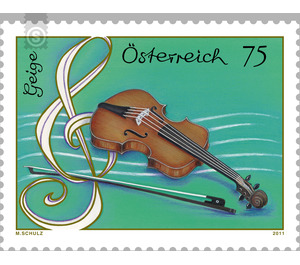Musical instruments - Austria / II. Republic of Austria 2011 - 75 Euro Cent
Theme: Art & Culture
| Country | Austria / II. Republic of Austria |
| Issue Date | 2011 |
| Face Value | 75.00 |
| Edition Issued | 180,000 |
| Printing Type | offset |
| Stamp Type | Commemorative |
| Item Type | Stamp |
| Chronological Issue Number | 2243 |
| Chronological Chapter | OOS-OE2 |
| SID | 248680 |
| In 53 Wishlists | |
"Musical instruments" is the sounding title of a new attractive brand series that now begins tactfully with the first value, the "violin". The violin, also called violin, is a stringed instrument that is mostly made of different woods. Your four strings (G, D, A and E) are painted with the so-called bow. In the tradition of classical European music, the violin plays a very important, often central, role - many famous composers have dedicated significant parts of their work to it. History: The first written mention of the violin goes back to the 16th century - in 1523, according to the historical source, received "les trompettes et vyollons de Verceil" (the trumpets and violins from Vercelli) at the court of the Duke of Savoy in Turin a fee. The oldest illustration of a violin, however, is a violin-playing cherub on the altarpiece in the church of S. Cristoforo in Vercelli. The still essentially unchanged form of the violin has been in use since about 1540 and originates from northern Italy. Famous Italian violin makers were Andrea and Nicola Amati, Gasparo da Salò and of course the world famous Antonio Stradivari. Further mention deserves Jakobus Stainer from Absam, whose instruments were considered the best until the end of the 18th century, and the Klotz family from the Upper Bavarian town of Mittenwald. The violins made at this time are today called Baroque violins, since the 1950s they are mainly used for the performance "Alter Musik". The tone production on the violin is a highly complex process, but there are many different types of bowing in bowing. Thus, in the staccato, the notes are played with the bow hard, fast and short, while Détaché or Martélé means to separate the notes individually, barely noticeably separated by a swab. In legato, in turn, several notes are joined together in a bow stroke, but in Tenuto the individual notes are played very powerfully. To stroke the strings with the wood of the bow is called col legno - and in the Spiccato the bow between the notes lifts off the string. In addition to the different bow styles, there is also the Pizzicato - the strings are made by picking with the index finger to swing. The versatile and so different use of the violin in music ranges from classical orchestral and chamber music over traditional folk songs to big band, dance, jazz and rock.


